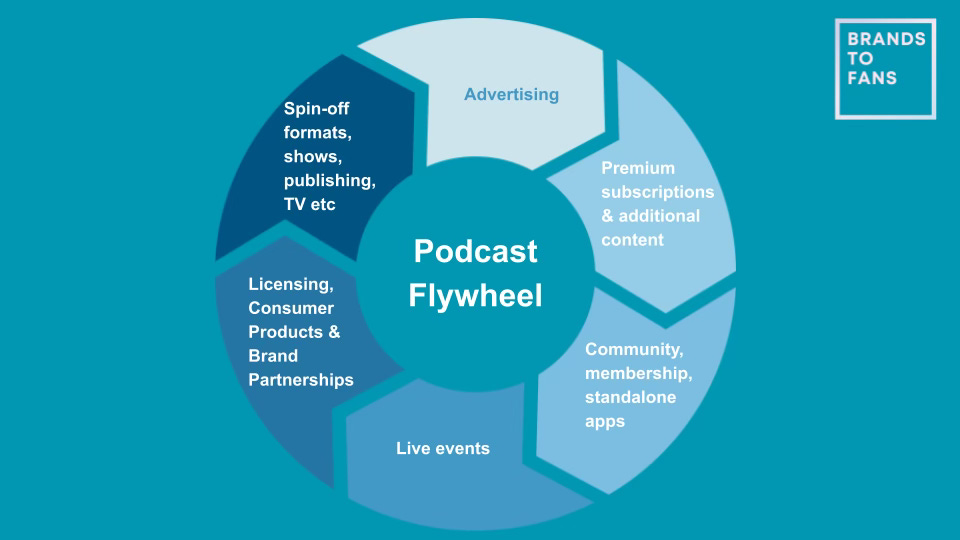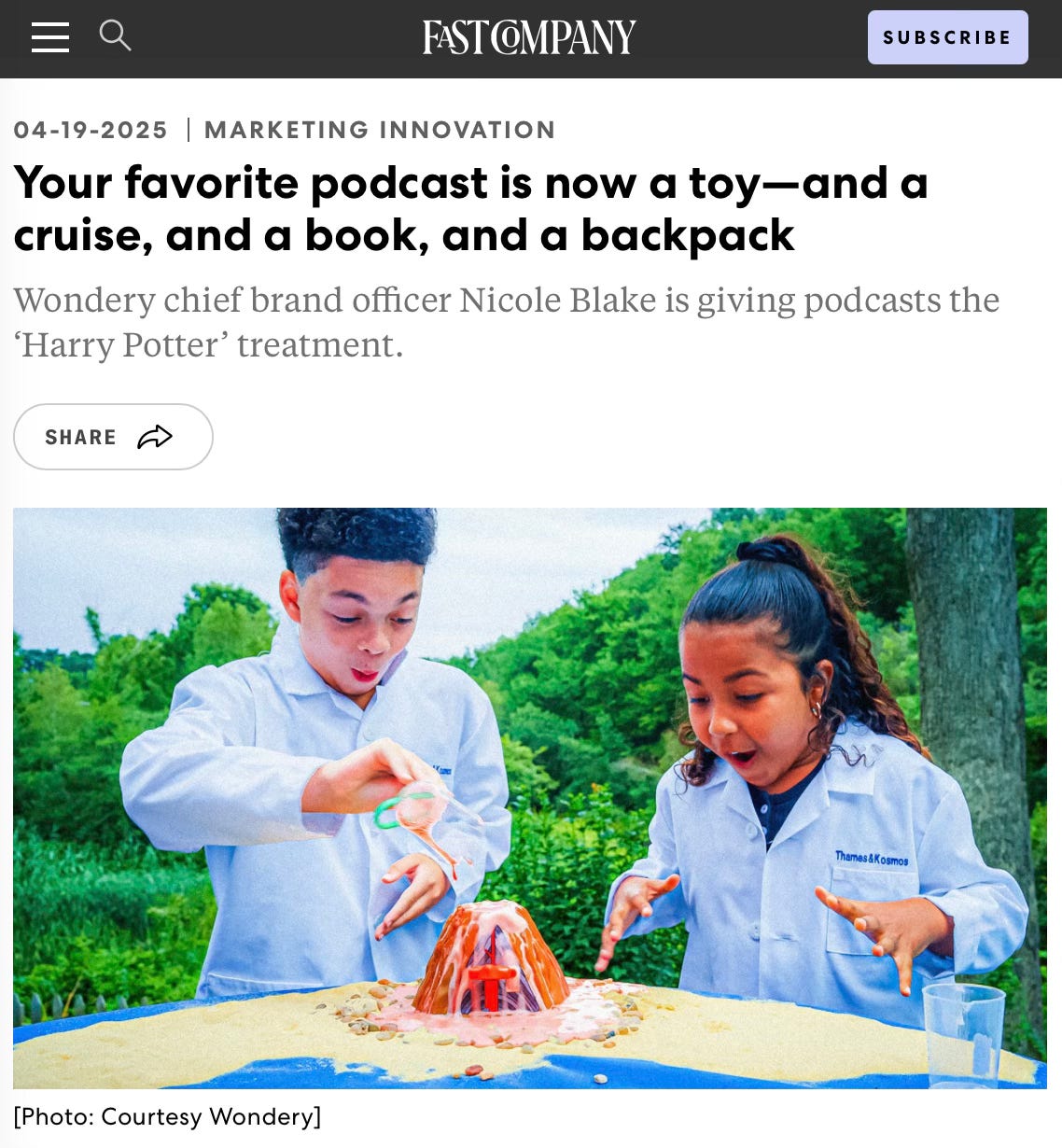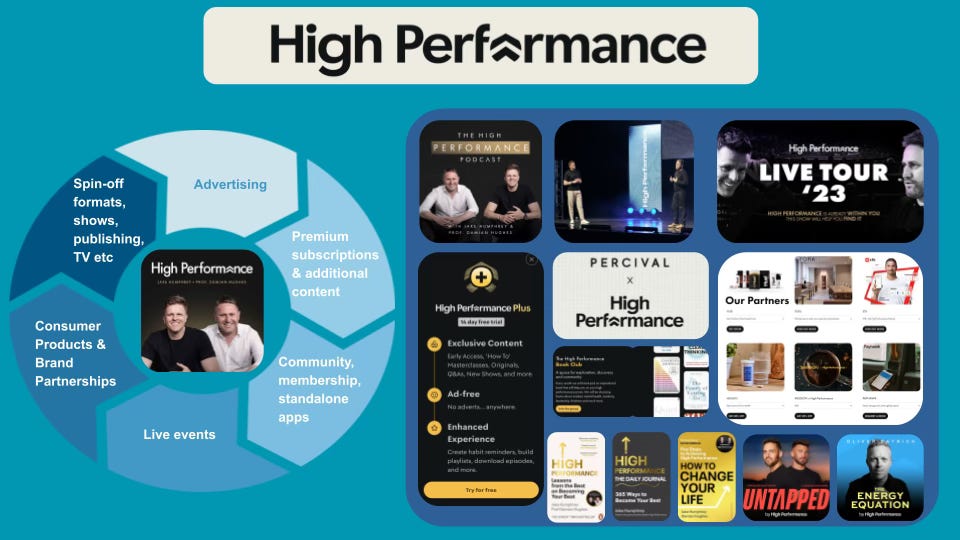Podcasting started as a niche hobby. Now it’s a billion-dollar flywheel of IP, monetisation, and brand extension. And it’s still in growth mode.
When Marc Maron announced the end of WTF recently, it felt like a closing chapter - not just for his show, but for the first era of podcasting. Back in 2010, WTF was an on-ramp to podcasts for many of us: messy, confessional, teetering on collapse. That was its charm. Now, 1,600 episodes later, it ends with Maron saying he’s “burnt out… but utterly satisfied with the work we’ve done.”
He should be. And the podcast industry itself has also evolved enormously during that period - none more so than in the past couple of years, when the complexity around distribution and monetisation opportunities has truly exploded. Owl & Co, the advisory firm run by Hernan Lopez (the founder of Wondery), recently sized the industry’s 2024 revenue at $7.3 billion, more than double previous estimates.
What started as a fringe format has evolved into an industrial-grade content engine. The most successful podcasts today are IP incubators, brand builders, and merch lines in waiting. They’re not content, they’re franchises in embryo. Today, a hit podcast means branded products, a book deal, a tour, and a TikTok clip of you crying.
From podcasts to shows
The Video-First Imperative
Video has emerged as the primary engine for audience reach and monetisation.
Dominance of YouTube: YouTube has become the leading platform for podcast consumption in the U.S., attracting 31% of weekly podcast listeners, surpassing Spotify (27%) and Apple (15%). Over 100 million people in the U.S. now watch YouTube on their TVs, with 46% of podcast viewers watching on smart TVs. 84% of Gen Z has watched a video podcast.
Higher Ad Engagement: Video podcasts on YouTube show an 87% completion rate for ads, compared to 28% for audio-only podcasts, indicating fans are less likely to skip ads. This direct relationship between creators showing their faces and ad engagement is a major draw for brands.
Platform Adaptations: Spotify, Amazon's Wondery, and SiriusXM are heavily investing in video support. Spotify introduced video in 2020 and now has 250,000 podcasters uploading video. Wondery is launching video episodes for its hit shows, like Armchair Expert. SiriusXM has signed deals for podcasts with popular video versions, such as Call Her Daddy.
Advanced advertising models & technology are driving core revenue
Dynamic Ad Insertion (DAI) and Programmatic: DAI, which Acast claims to have pioneered in 2014 (although I recall Sean Carr, founder of Art19, working on it in 2012!), allows ads to be inserted dynamically based on listener demographics or timing, offering flexibility and relevance. Programmatic advertising is also scaling, allowing automated ad buying.
Shift to Bigger Brands: Larger, established brands like BMW, DraftKings, and Home Depot are increasingly advertising on podcasts, particularly those with the largest audiences, moving beyond the startup brands that have historically dominated podcast advertising. Which is a relief, really, because if you haven’t launched a Squarespace website or bought a new mattress by now, are you ever likely to?
Host-Read Ads: These continue to be preferred for their authenticity and higher trust among listeners, leading to higher CPMs ($25-$40 per 1,000 listeners compared to $15-$30 for pre-recorded ads). However, large sponsors may prefer pre-recorded ads for scalability.
Increased Ad Load: The average ad load in podcasts increased from 7.9% of runtime in Q2 2021 to 10.9% in Q2 2024.
Advertising Landscape: Podcasts can offer exceptional Return On Ad Spend (ROAS), with Acast claiming 56% higher short-term (ROAS) than the average media channel and the best long-term return at 4.9x (compared to an average of 3.7x across all media). This demonstrates a compelling value proposition to advertisers used to other mature advertising markets.
The monetisation flywheel is finally spinning: podcasting enters its franchise era
While advertising remains the dominant business model, profitability increasingly relies on multiple revenue streams.
Subscriptions: Platforms like Patreon are enabling direct listener support, with podcasters earning over $472 million last year from more than 6.7 million paid memberships, making podcasting Patreon's highest-earning creative category. SiriusXM has launched a $ 6-per-month subscription bundle for its shows, including ad-free access and bonus content. The New York Times has also moved more podcast content, including The Daily and Serial, behind a paywall. The UK’s Goalhanger has individual subscription options for each of its ‘The Rest is … ’ shows, but must surely be looking to launch an overall subscription product across all shows (as Wondery has done with Wondery+).
Live Events: Popular podcasters like The Rest Is Politics have sold out major venues, such as the O2 Arena in London, while MrBallen embarked on a 15-city theatre tour. These events can also incorporate sponsorships and merchandise sales.
Licensing & Merchandising: Selling branded merchandise and products is a powerful way to monetise a loyal fanbase and build community.
Examples include New Heights selling apparel and The Skinny Confidential launching its own product line, with their mouth tape generating over $7 million in sales last year. This is the same transformation that is happening across the broader creator economy, as covered in my previous newsletter How the Creator Economy is adapting and supercharging the traditional franchise flywheel.
Wondery’s expansion of its brands across a range of products and merchandise is being driven by my former Harry Potter colleague, Nicole Blake, who is now the Chief Brand Officer for Wondery and gave a great interview to Fast Company about their approach.
The IP engine: Podcasters are transforming their shows into online courses and paid live boot camps, and licensing their intellectual property (IP) for books, docuseries, and TV adaptations. Podcasts have long served as a development lab for film and TV producers, offering a less expensive way to workshop ideas and test story concepts before committing to screen productions. Wondery, for example, has seen many of its podcasts adapted into TV series, such as Dr. Death and The Shrink Next Door.
Fostering Fandom & Community: Driving all of these monetisation opportunities is the deep, often parasocial fandom connection that successful shows can build. Fans proudly wear branded apparel, attend live events, and engage on social media, treating hosts like friends. They also provide valuable feedback loops that can inform future directions for the brand.
High Performance, for example, in the UK, has evolved from a podcast featuring interviews with high performers into a coaching, well-being, and inspiration app platform offering lessons, insights, and learning from over 200 guests interviewed over the last four years. It has content spin-offs, tiered membership, live events, corporate training, merch, publishing, a book club, and a charity foundation arm, Game On.
Deal flow continues to build
Valuation Benchmarks: The acquisition of Lemonada Media by PodX for a reported $30 million sends a clear signal about the value in brand equity and the return of strategic buyers.
Mega Deals for Stars: Top talent continues to command high-value deals. Joe Rogan re-upped his deal with Spotify for up to $250 million. Alex Cooper signed a $100 million deal with Sirius for Call Her Daddy, and Dax Shepard signed an $80 million deal for Armchair Expert with Wondery, who also signed the Kelce brothers’ New Heights for a reported $100 million.
Independent Success: Nick Viall, former Bachelor contestant, signed a deal with Libsyn valued at $20-30 million for his show The Viall Files and network Envy Media. Steven Bartlett, founder of The Diary of a CEO, reportedly turned down deals of over $100 million in favour of building his own multi-platform media empire, Flight Story, which generated $20 million in revenue in 2024 from brand partnerships, speaking engagements, and products.
M&A: In the UK, Platform Media merged with Listen Entertainment and Goldhawk Productions to form a ‘podcasting supergroup’ with combined revenues ‘deep into eight figures and over 70% growth in the past year’. Acast also completed the acquisition of Wonder Media Network (WMN) in January 2025, a creative studio that will combine with Acast's existing creative team to form Acast Creative Studios.
Future Evolution
The podcasting sector is poised for continued transformation, moving towards a post-podcasting era.
Omnichannel Ecosystems: The future will be defined by show-based IP ecosystems, built for reach and monetisation across multiple formats and platforms. Content will be produced once and distributed everywhere – Apple, Spotify, YouTube, TikTok, and Instagram. This operational leverage and ‘platform fluency’ will be key to success.
Creator-Centric Businesses: Creators are no longer just podcasters; they are showrunners, marketers, business operators, and brand builders. Future success stories will come from deep partnerships that provide comprehensive infrastructure, production, and monetisation strategy support.
Standardisation and Measurement: A critical challenge remains the lack of a shared definition and consistent measurement frameworks across platforms. Industry leaders are calling for an open measurement protocol for podcasting to enable consistent, privacy-safe measurement across various platforms, which is essential to unlock ad investments currently held back by uncertainty.
Integration of Social Commerce: Platforms such as Netflix are exploring the addition of video podcasts with shoppable content, leveraging deep audience data for personalised recommendations and interactive features, which could redefine how consumers shop online.
Role of AI: Artificial intelligence is already being used in content creation, such as voice translations, and in ad generation and targeting (e.g., Spotify's AI-narrated audio ads), and is sure to have further impact on production efficiency, personalisation, and monetisation.
The podcast industry is no longer just an audio medium but a dynamic, cross-platform entertainment and commerce powerhouse. Its future success hinges on adapting to video-first consumption, diversifying revenue streams, fostering deep creator-audience connections, and establishing industry-wide measurement standards to attract scaled investment.
Further Reading
There are a host of podcast news sources and newsletters out there. Here on Substack I have been enjoying
’s and ’s Matt On Audio.Franchise news roundup
Each week, we round up franchise management news, focusing on items that relate to previous newsletter topics.
Franchise Building
(Read my post Building a Forever Franchise here.)
Invincible creator Robert Kirkman discussed the lessons he learned from The Walking Dead that enabled him to better “lay the track” from a storytelling perspective for Invincible. Read More
Theme Parks & Immersive
(Read my theme park deep dive here and Immersive deep dive here.)
Netflix revealed the IP line-ups for its first two Netflix House attractions, which will open later this year. In Philadelphia, Netflix House will offer Wednesday: Eve of the Outcasts and One Piece: Quest for the Devil Fruit, as well as VR Games, mini golf and a Netflix theatre. Netflix House Dallas will offer Stranger Things: Escape the Dark and Squid Game: Survive the Trials, as well as Netflix RePlay, a game room with physical challenges, immersive story rooms and retro-style games. Read More
Meow Wolf partnered with Niantic to expand its immersive world via geospatial AR. Read More
Paramount are launching a new immersive Dexter experience in London. This is more of a promotional execution - it will run for a limited time, timed to coincide with the premiere of Dexter: Resurrection on July 11. Read More
Preschool, Kids & Family
(Read my post Whole Lotta Bluey here.)
BBC Studios Digital Brands signed Bing as its first third-party IP. Read More
Shelley Macintyre, SVP of Marketing at BBC Studios, unpacked the latest Bluey developments here
Faith-based franchises
(Read my post How faith-based content is driving innovation in funding, distribution and fan engagement here.)
Lifetime is launching a slate of faith-based films, “centered on women facing unfathomable circumstances who use their faith to lead them through.” Read More
Amazon finished casting its faith-based series It’s Not Like That. Read More
The History Channel has greenlit the 10-part series The Bible Revealed. Read More
He didn’t get the Kool-Aid movie, but Martin Scorsese has had his series Martin Scorsese Presents: The Saints renewed by Fox Nation for a second season. Read More
Creators
(Read my post How the Creator Economy is adapting and supercharging the traditional franchise flywheel here.)
YouTuber PrestonPlayz (66 million subscribers and 22 billion views to date) has signed with Bonkers Toys for a range of toys including plush, role play, mystery merch boxes and more, to launch in Spring 2026. Read More
The streamer Tubi launched a digital content creator programme under ex-Vimeo exec Rich Bloom. Read More
Fandom
(Read my post When Superserving becomes Supersqueezing here.)
Dan Goldberg wrote a great piece on the importance of casual fans and constructing pathways to acquire them, as well as communities that convert them into diehards. Read More
Live-action remakes
(Read my post Why live-action remakes are not going anywhere here.)
Lilo & Stitch and How to Train Your Dragon are currently at #1 and #2 at the US Box Office. HTTYD’s director, Dean DeBlois (who also directed the animated original), spoke to the Hollywood Reporter about his process. Read More
John Wick
(Read my John Wick deep dive here.)
The Wrap ranked the best John Wick action scenes (Ballerina is at #2, which seems like recency bias to me!). Read More






